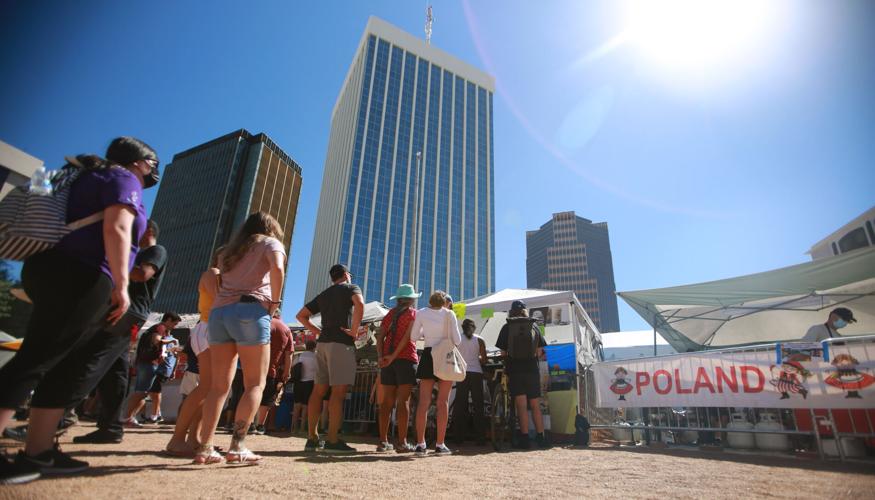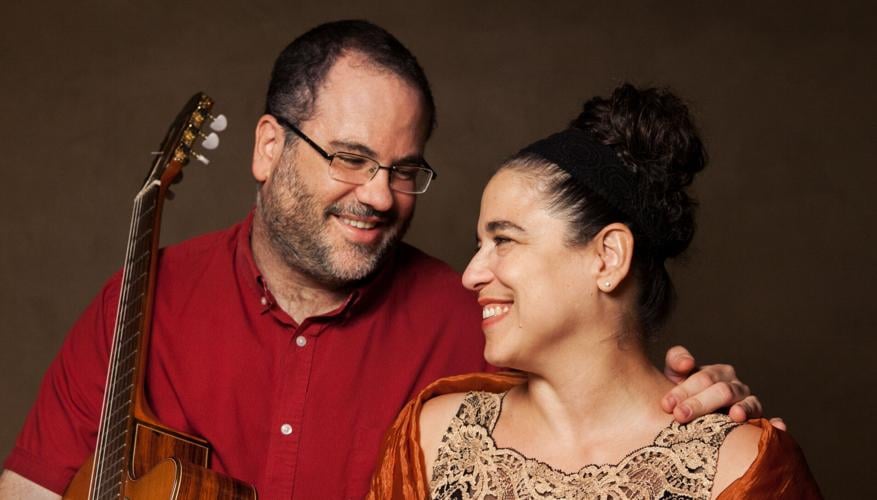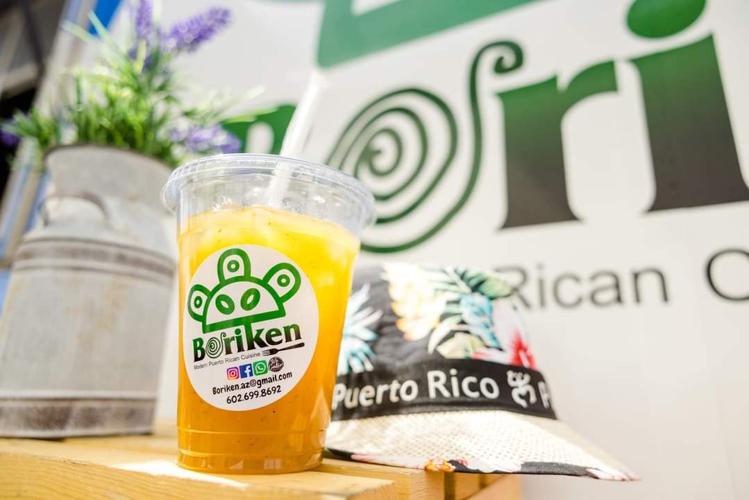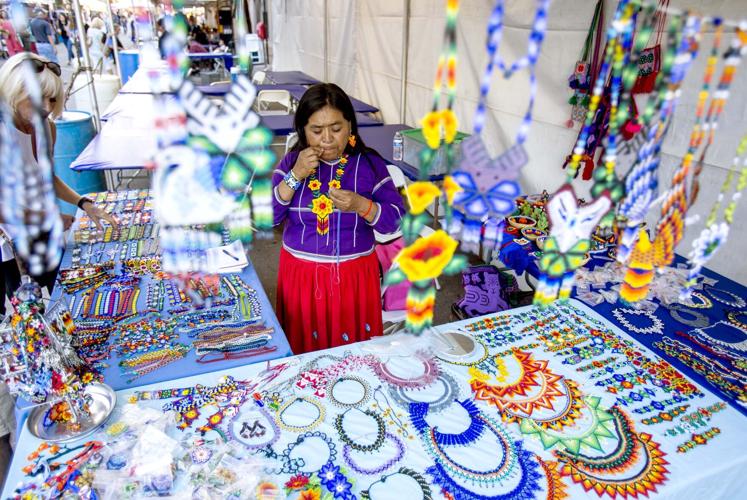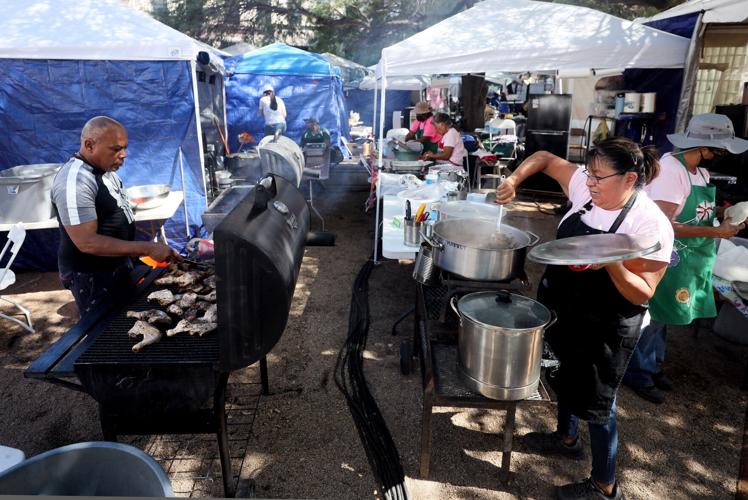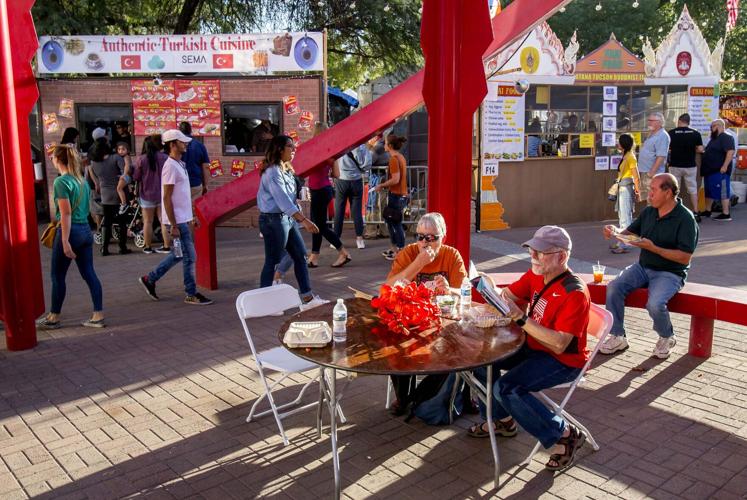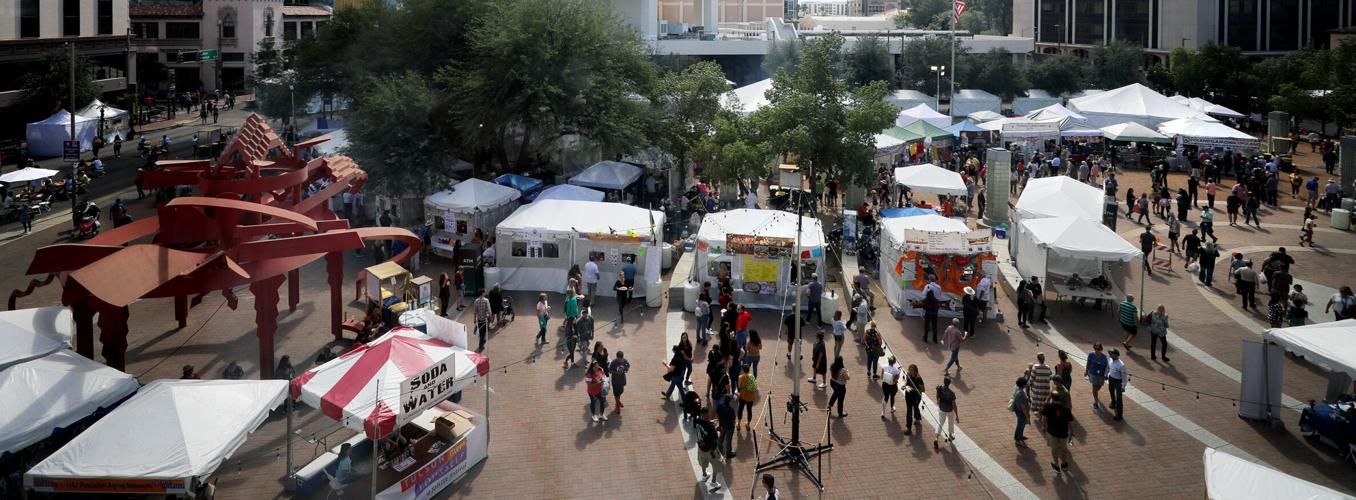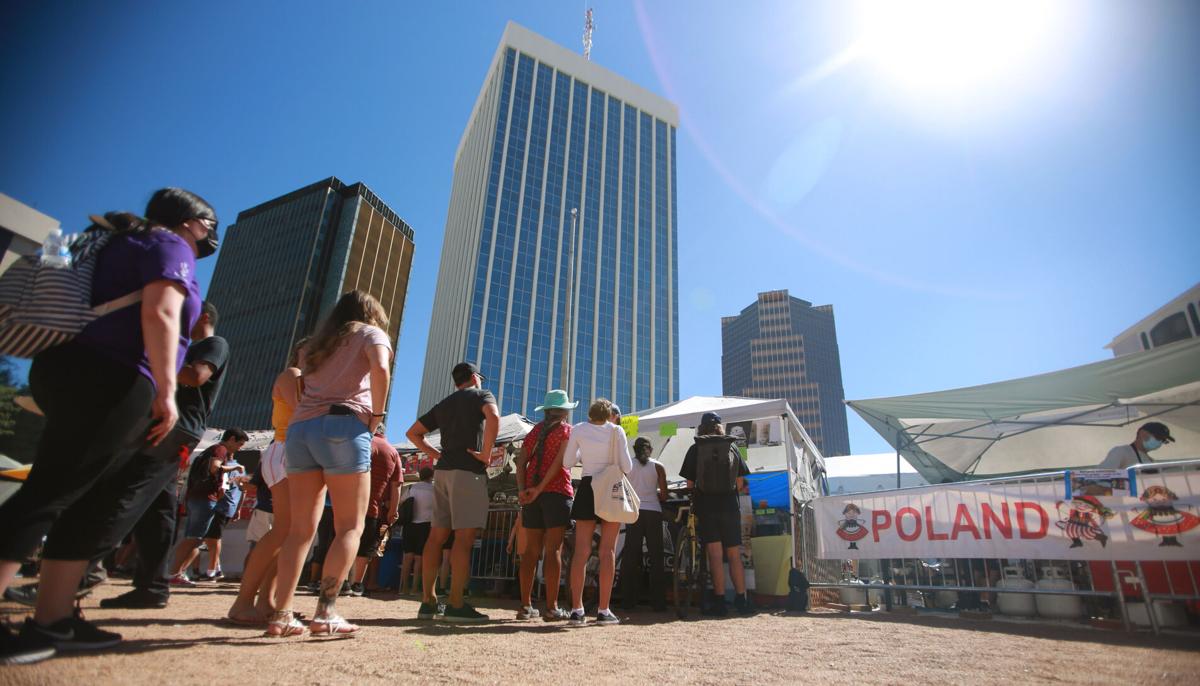Tucson Meet Yourself — the annual multicultural festival hosted by the Southwest Folklife Alliance — is celebrating its 50th anniversary when it returns to Tucson this month.
This year’s festival kicks off at 11 a.m. Friday, Oct. 13, at Jácome Plaza, 101 N. Stone Ave. in downtown Tucson. The festival runs from 11 a.m. to 10 p.m. Friday-Saturday, Oct. 13-14 and 11 a.m. to 6 p.m. Sunday, Oct. 15.
Admission for Tucson Meet Yourself is free, but festival organizers hope community members will consider making a monetary donation, in any amount, through new QR codes that can be found around the festival.
Along with the new QR codes, Tucson Meet Yourself will have a few other additions this year such as a new Heritage Beer Garden in partnership with Borderlands Brewing Company, more accessibility around the festival grounds and a memory tent filled with vinyl, shag carpeting and Rubik's Cubes — all of which honor the festival’s inaugural year, 1974.
“Times have really changed from when Tucson Meet Yourself began and I think that you will see the festival being a little bit reflective,” said Maribel Alvarez, the festival’s co-director who has been involved with the event since 2005. “Not only on how Tucson Meet Yourself changed but how it has changed with Tucson. Fifty years is a long time for a community. And I think of the endurance of the ideas and the ideals when Tucson Meet Yourself was established in 1974, there was no real currency of language about multicultural inclusion (then).”

Artisan Maria Guadalupe Velázquez beads jewelry during Tucson's annual Tucson Meet Yourself Folk Festival in Jácome Plaza in downtown Tucson on Oct. 11, 2019.
The annual festival showcases food, arts, languages and more from numerous cultures around the world, all of which help make up Tucson’s cultural diversity. A few of the cultures you can experience at Tucson Meet Yourself include Puerto Rican, Taiwanese, Polish and Ukrainian.
“In our everyday life, we have a tendency to exist inside of our bubbles, right? We go to work, we go to school, we have our friends and it is so unusual to be able to experience the breadth of experience that is possible in Tucson,” said Bryan Falcón, the co-director of the festival. “And it's one of the reasons I first got involved with the Southwest Folklife Alliance before I started with Tucson Meet Yourself. There was just a desire to say ‘Who is out there? What do I not know? What are the blinders I have to my existence? How can I better understand what makes Tucson, Tucson?’”
Tucson Meet Yourself is what the co-directors like to refer to as an educational experience.
“It's enlightening to be able to be there,” Falcón said. “And it's the coming together of people. It's the coming together of Tucson. This just doesn't happen anywhere else.”

People meander through the 49th annual Tucson Meet Yourself in downtown Tucson on Oct. 7, 2022.
A big festival with an even bigger legacy
Tucson Meet Yourself was created by the late local folklorist and anthropologist James S. “Big Jim” Griffith and his wife, Loma, in 1974, after the couple experienced a folklore festival in El Paso a couple years prior, according to a Tucson Meet Yourself commemorative magazine.
The Griffiths were inspired to have something similar in Tucson that would embrace the area’s cultural diversity and richness — especially after Tucson’s Urban Renewal Project in the 1960s tore through local barrios leaving community members scrambling to preserve the area’s history and culture.
“The idea behind this event is to present in one place traditional singers, musicians, dancers and craftspeople from as many of Tucson’s ethnic communities as possible,” Big Jim Griffith told the Tucson Citizen on Oct. 2, 1974.

Anthropologist and folklorist "Big Jim" Griffith plays banjo on the front porch of his home on Mission Road southwest of Tucson in 1974.
The first Tucson Meet Yourself in October of that year was a two-day festival in El Presidio Park sponsored by the Tucson Cultural Exchange Council, an organization dedicated to creating a “cultural exchange between Arizona and Sonora, Mexico.”
The inaugural event brought together an estimated 2,000 people and cost a projected $4,000 to put on, according to the Arizona Daily Star.
Tucson Meet Yourself now welcomes more than 150,000 people each year. The festival now costs around $500,000 to put on, according to Alvarez.
For Griffith, Tucson Meet Yourself was never about having a big party. It was about giving the community an opportunity to explore and learn about the cultures, traditions and people that make Tucson what it is.

Liekarring dancers sponsored by the Norseman's Federation at the 1981 Tucson Meet Yourself in downtown Tucson.
“He was a professor, he was a folklorist, he was very thoughtful,” Alvarez said. “He always worried that it was just a party. And then at the same time, he came to recognize that it was the party, the festival move, it was the music, it was the dancing in the street, it was the food, that actually opened the possibility of people coming and experiencing that. So, that's the kind of person he was. He was always so sure of something, but also open to learning.”
Griffith’s openness to learning — a part of his legacy — is something the organizers carry with them when they listen to community feedback and plan the event every year.
The desire to always put their best foot forward for the community is what led to some of the newer changes at the festival, like more accessibility, including a tranquility tent for those who need a breather from the hustle and bustle of the event, a lactation tent for mothers and even livestream captioning for performances.
“Something we're pretty proud of and that we've really listened to the community is in terms of accessibility,” said Kimi Eisele, the festival’s communications manager. “We've really, in the last few years, started making some improvements. But this year, we were able to raise the money to hire an accessibility coordinator — someone whose job it is to really think about how the festival can meet accessibility goals and make sure that we're creating a space that people of all abilities and disabilities can enjoy. It was something that needed to happen for a long time. And so finally this year, we could dedicate the funding to that and it's just been pretty incredible.”
Music is the heartbeat of the festival
After outgrowing its previous space in El Presidio Park, Tucson Meet Yourself has called Jácome Plaza and its surrounding blocks home for the last five years.
Every fall, the space is filled with the sounds of strangers chatting, children enjoying themselves and vendors sharing their cultural stories with anyone who passes by.
The loud beats of taiko drumming, the strums of guitars and the sweet serenades from local singers can also be heard while walking through the festival.
Nossa Bossa Nova, comprised of husband and wife Mike and Theresa Levy, is set to perform at the festival from noon to 12:45 p.m. Friday, Oct. 13, at the Rio Nuevo Stage on Church Avenue. They're just one band out of dozens who will take the three stages throughout the weekend.
“It makes me feel so good about Tucson and just being filled with people from all different cultures with the food and the music and it really showcases the diversity of our community,” Theresa Levy said of Tucson Meet Yourself. “And I love that about Tucson. It makes me feel good about connecting with the community in this way. And it really makes me feel warm inside.”
The duo has made music together in Tucson for around 20 years. This year marks their ninth year playing at Tucson Meet Yourself.

Mike and Theresa Levy of Nossa Bossa Nova will be performing at the 50th anniversary of Tucson Meet Yourself on Friday, Oct. 13.
“Though neither of us are Brazilian, we've done this for a long time,” Mike Levy said. “And we're both very passionate and Theresa is fluent in Portuguese and she puts on a great show and talks about what the songs are about. … And it's gorgeous music and captivating emotions; there are so many emotions and poetry in the lyrics.
“A lot of people think bossa nova and they think, oh, ‘The Girl from Ipanema’ song but it goes so much deeper. There's so much beautiful music and romantic poetry involved and really, really deep emotions and the melodies are so gorgeous. And then also it makes you want to maybe move or draws you into the drama, whether they're ballads or they're upbeat, the songs are so expressive.”
If you’ve seen Nossa Bossa Nova at Tucson Meet Yourself in the last five years, chances are you’ve seen them perform with their son Lorenzo. This year will be the first year they'll perform without him because he recently moved away for college.
But whether Nossa Bossa Nova is a duo or trio at the festival, they hope that Tucson Meet Yourself is something they can continue doing for years to come.
“We love doing it. We hope we do it for as long as we can,” Mike Levy said.

Yoeme Barrio Libre's frybread at Tucson Meet Yourself 2021.
Tucson Eat Yourself
As you dive deeper into the festival, the sights and sounds of the event take the back burner as the smells from numerous food vendors become front and center.
One slight breeze and you get a whiff of the rich spices from Indian cuisine, the slight sweetness from freshly fried churros and a touch of smokiness from Filipino barbecue skewers.
To say that food is an important part of Tucson Meet Yourself would be an understatement. After all, the annual festival is often referred to as Tucson Eat Yourself.
The festival brings out the best local home cooks, chefs and food trucks, all of whom are excited to share their meals and cultures with the community. More than 50 food vendors will be at this year's festival.
For Carlos Garcia, the owner of the bright teal Boriken Modern Puerto Rican Cuisine food truck, Tucson Meet Yourself is another way to share his Puerto Rican culture with Tucson.
This may only be Garcia’s third year participating in the festival, but it’s something that he's wanted to be part of since moving to Tucson in the late 2000s.
“I remember the first time that I went to the festival, it was in 2009,” he said. “But when I saw that dynamic of the festival, that you (eat) all this food from different countries, (it) was unique. And since that day, I remember I told my wife, ‘I want to be part of that.’”

The Boriken Modern Puerto Rican Cuisine food truck will be at Tucson Meet Yourself's 50th anniversary festival. It's the truck's third year participating in the festival.
Garcia, who previously worked at five-star resorts around the world, opened the Boriken food truck during the height of the COVID-19 pandemic. Since starting the food truck with his wife, the couple has served classic Puerto Rican food with a modern twist.
Some of the dishes Boriken will be serving at this year's festival include a bowl with roasted pork and pigeon pea rice, carne frita con mofongo (also known as fried chunks of pork with mashed garlic plantains) and a Puerto Rican take on nachos, made with roasted pork and plantains.
The first year Garcia participated in the festival, he says he felt a little unprepared due to the sheer amount of people. But he took feedback from festival goers and made sure he was extra prepared the following year.
Overpreparing paid off because Garcia says he received primarily positive feedback on their fast service and menu last year and he’s excited to see what he can do this year.
“I’m very proud of (participating in) a cultural event where I represent my culture and explain where we come from and why our food is so bold and flavorful,” he said.

Tessa Bielecki and David Denny, co-directors of nonprofit Desert Foundation, finish eating their food during Tucson's annual Tucson Meet Yourself Folk Festival in Jácome Plaza in downtown Tucson on Oct. 11, 2019.
50 years down, at least 50 more to go
A lot has changed over the last 50 years at Tucson Meet Yourself.
The event increased from two days to three, the venue changed and the number of attendees has increased significantly throughout the years.
The organizers of the festival have even bigger dreams for the next 50 years, as they hope to turn the festival’s mission into something that can benefit the community every day and not just a few days every fall.
“I’d like to see us get more into, in the next 10 to 15 years, entrepreneurial development of communities through food,” Alvarez said. “I imagine something like a commissary kitchen that we can provide to some food incubation businesses. So, I'd like to see the festival's mission tied more to economic prosperity development in some of our small businesses. That, right now, seems a little bit beyond our capacity to do that. But it's always been a dream that it (Tucson Meet Yourself) would be a year-round incubator.”
“We have this amazing coming together, the people into the place, and then it goes to sleep for a little while until it comes back again next year and the next event happens,” Falcón added. “So, what happens if Tucson Meet Yourself can be something that on a regular basis is presenting all kinds of insights into the cultural world of folklife of Tucson?”

Albert “Romeo” Morris, far left, cooks up jerk chicken for the Pam’s Kitchen booth as Lorinda Harvey, far right, stirs red chile for the O’odham Ladies booth during the 49th annual Tucson Meet Yourself in downtown Tucson on Oct. 7, 2022.
Something that hasn’t and won’t change in the next 50 years: keeping the festival homegrown and community-centered. Because for the organizers 50 years ago and the organizers today, Tucson Meet Yourself is the people’s festival.
“It is the signature event that said something about diversity in a very radical proposal of inclusion at a time when that was not,” Alvarez said. “So what I'd like people to see is that it’s not just any other event, it is what the Arizona Daily Star … called the festival of festivals because Tucson has now over 60 festivals — festivals of all kinds — but to see Tucson Meet Yourself as an elder brother or sister that has actually paved the way for creating a language of comfort around accessibility (and diversity), I take pride in that.
“What really remains to me most amazing about Tucson Meet Yourself is that it is the people's festival. There’s just a sea of humanity.”
For more information about this year’s festival including performance schedules and a list of food vendors, check out Tucson Meet Yourself’s website.
The annual Tucson folklife festival returns to Tucson to celebrate the diverse communities and people living in and around the Old Pueblo.
Founded in 1974 by Tucson folklorist Jim Griffith and his wife Loma, Tucson Meet Yourself brings thousands of people from different cultures, countries, and ages together to enjoy live music and dancing and feast on some traditional cuisine from all parts of the globe.
This year's 48th annual festival will be smaller than in past years, but will still have a schedule full of entertainment. Video by Jesse Tellez / Arizona Daily Star.


